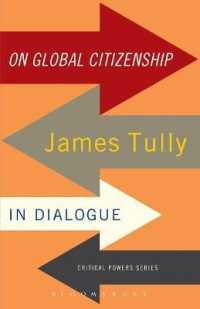- ホーム
- > 洋書
- > 英文書
- > Nature / Ecology
Full Description
"This very timely book provides a comprehensive exploration of the current status of pollinators in farming and the strategies to promote pollination by insects other than honeybees. The editors, Peter Kevan and Susan Willis Chan, have assembled contributions from a large number of experts in the area of crop pollination, bee ecology and pathology...this book presents a state-of-the-art account of an essential topic and will remain a very useful resource for years to come. The Burleigh Dodds series in agricultural science aims to provide researchers with advice for sustainable food production. This volume does more than that: it will be a go-to reference not only for researchers but also for farmers and agronomists, policymakers and NGOs interested in learning about advances in techniques and protocols in promoting a crucial ecosystem service." (Dr Katja Hogendoorn, The University of Adelaide, Australia)
It has been reported that up to 95% of all flowering plants require the services of other organisms to move pollen from male to female flower parts during the pollination process. These organisms, including bees, are collectively known as pollinators. However, in light of the growing evidence of global declines in pollinator species, the management, ecology and conservation of wild and managed pollinators is a subject of growing importance and research activity.
Promoting pollination and pollinators in farming reviews the wealth of research on our current understanding of existing pollination processes and their importance to our global ecosystems. The book considers how pollinators interact with plants, as well as the major threats to pollinator species, including climate change, diseases and pesticide exposure.
Through its comprehensive exploration of the current status of pollinators in farming, the book provides its readers with the knowledge required to promote pollination by protecting the world's pollinators species and the ecosystem services they deliver using techniques such as habitat conservation.
Contents
Part 1 Understanding pollinators and pollination
1.What is pollination and what are pollinators in agriculture?: Seanne Clemente and Lynn Adler, University of Massachusetts, USA;
2.The role and application of olfaction in crop plant-pollinator interactions: Sarah E. J. Arnold, Natural Resources Institute, University of Greenwich, UK and Nelson Mandela African Institution of Science and Technology, Tanzania; Alison S. Scott-Brown, University of Cambridge and Royal Botanic Gardens, Kew, UK; and Philip C. Stevenson, Royal Botanic Gardens, Kew and Natural Resources Institute, University of Greenwich, UK;
3.The role of wind pollination in crop plants: Stephen Murphy, University of Waterloo, Canada;
Part 2 Threats to pollinators
4.Assessing climate change impacts on pollinators: Kit Prendergast, Curtin University, Australia;
5.Assessing the impact of disease on pollinators: Patrycja Pluta and Robert J. Paxton, Martin Luther University Halle-Wittenberg, Germany;
6.How neonicotinoid insecticides affect bees and other pollinators: D. Susan Willis Chan, University of Guelph, Canada;
7.Assessing the impact of pesticides on pollinators: Christian Maus, Bayer AG, Germany; Anne Alix, Corteva Agriscience, UK; and Daniel R. Schmehl, Bayer CropScience LP, USA;
8.Assessing the impact of alien bees on native ones: M. Zakardjian, H. Jourdan, V. Le Féon and B. Geslin, Aix-Marseille University, Avignon University, CNRS, IRD, IMBE, Marseille, France;
Part 3 Promoting pollinators and pollination
9.The role of habitat conservation and restoration in protecting
pollinators in agricultural landscapes: Stephen Buchmann, University of Arizona, USA;
10.Altering crop management practices to promote pollinators: Jose G. Franco, USDA ARS, USA; and Rachel E. Mallinger, University of Florida, USA;
11.Ecological network approaches for promoting pollinators in agriculture: Darren M. Evans and Fredric M. Windsor, Newcastle University, UK;
12.Best management practices for pollinator protection in US
apple production: Julianna K. Wilson, Michigan State University, USA; David Biddinger, Penn State University, USA; David Epstein, Northwest Horticultural Council, USA; Anne Nielsen, Rutgers University, USA; Ngoc Phan, University of Arkansas, USA; Jim Walgenbach, North Carolina State University, USA; and Neelendra K. Joshi, University of Arkansas, USA;
13.Entomovectoring: using pollinators to spread biocontrol agents: Jari Temmermans, Ghent University and Antwerp University, Belgium; Marie Legein and Sarah Leeber, Antwerp University, Belgium; and Guy Smagghe, Ghent University, Belgium;








